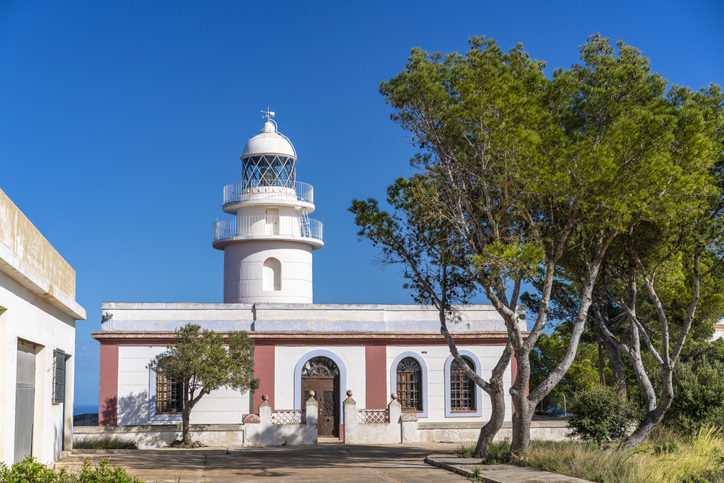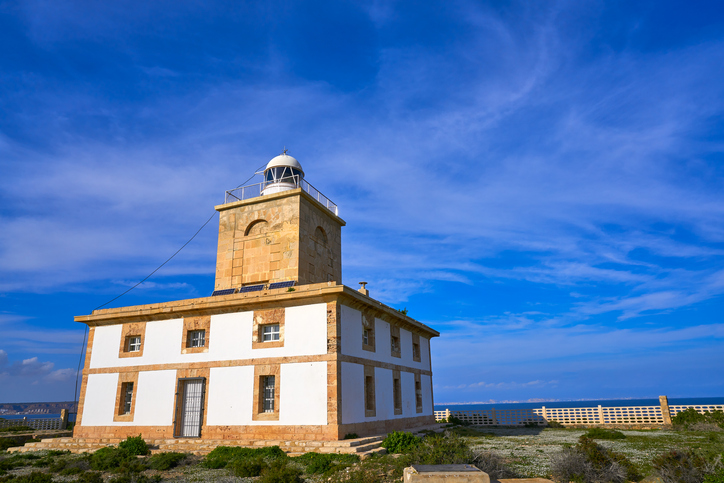The lighthouse of Alicante, located in Cabo de la Huerta, is not the only one in the region. In total, there are another six scattered along the coastline. As such, you can enjoy a fantastic route that will take you all along Alicante’s Mediterranean coast. You will come across unique views, and you’ll also have the chance to visit one of Spain’s prettiest islands.
Starting the Alicante Lighthouse Route
Alicante’s coast stretches across 250 km in total, offering you an excellent opportunity to discover the region’s history and culture.
What’s more, the Lighthouse Route doesn’t end on the mainland. As we mentioned earlier, you’ll have to take a boat. We’re certain that exploring these lighthouses will be an experience like no other. To embark on this adventure, you’ll need to head to Jávea.
The lighthouses of Jávea
Jávea is home to two lighthouses. One of them, located further to the north, is in Cabo de San Antonio. It started operating in 1855 and continues to shine its guiding light for boats today.
While the lighthouse itself is only 17 metres tall, it sits on top of a cliff. As a result, its highest point towers 175 metres above sea level, allowing its light to shine up to a distance of 26 nautical miles on a clear day.
The Lighthouse of Cabo de la Nao is located a few kilometres to the south. It is more modern than the previous one, dating back to 1928. What’s more, you can even go inside, offering a first-hand experience of the challenges of life as a lighthouse keeper.
In fact, this lighthouse is still inhabited. As for its light, while it’s not as powerful as the one in San Antonio, it is capable of reaching a distance of 23 nautical miles.

The lighthouse of Moraira
Moraira is a small town to the north of the region and belongs to the municipality of Teulada. It is home to one of the oldest lighthouses in Alicante. While it is no longer in use today, the Cap d’Or watchtower had great strategic significance for centuries.
To get there, you’ll need to put on your hiking boots and follow a small nature trail. The views from the Cap d’Or watchtower are definitely worth it.

Lighthouse of Albir
This lighthouse sits atop Punta Bombarda, a small hill in the Serra Gelada Nature Park. To get there, you’ll need to walk for about 2.5 kilometres. In the lighthouse’s surroundings, you will also come across a former ochre mine as well as the old Bombarda Tower, a lookout point that helped to fight against privateers.

Lighthouse of Tabarca
The island of Tabarca has a close relationship with the sea. It is located just 8 km from Santa Pola and is the only inhabited island in the Community of Valencia.
Descendants of Genoese sailors rescued from the Tunisian island of Tabarka by King Charles III have been living there for three hundred years. This is what earned the island its name. Its lighthouse rises just 29 metres above sea level and started operating in 1854.
Here you will find a wide selection of restaurants, souvenir shops and an extensive beach. It is also a breeding area for many seabirds.

Lighthouse of Santa Pola
This is where our route ends. It was built in 1859 and towers 152 metres above sea level, even though the lighthouse itself is only 15 metres tall. When you visit this town, you simply cannot miss out on its salt lakes and golden beaches, four of which are blue-flag certified.

Interesting facts about the lighthouses in the region of Alicante
As you can see, many of the lighthouses began operating in the mid-19th century. This was the result of the Coastal Lighting Plan that was approved in 1847.
Though Alicante’s lighthouses are not particularly tall, Spain is home to some much larger ones too. One example is the lighthouse of Chipiona, with a height of 69 metres.
Planning your journey along the Alicante Lighthouse Route
Before embarking on your journey to the different lighthouses in Alicante, it’s essential to keep a few things in mind. While not all of them are open to the public, some are. Even so, each one is open on different days and at different times. Therefore, you will need to plan your route in advance. You can also take the opportunity to visit other towns in the region, as there are plenty of places worth exploring.
It is common to come across a lighthouse in Alicante, since the region has an extensive coast. All of them have their own story and will take you on a journey to the past. That being said, they’re still very useful today, especially during bad weather. Remember to book your accommodation in advance. At Sol Habitat, we have the best options for you.






